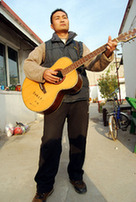By He Shan & John Sexton
China.org.cn staff reporters
The first thing that visitors encounter in the main display area of the Culture and Arts Museum of Migrant Labors near Beijing Capital International Airport is a large red banner bearing the words: "Respect for labor and laborers is a basic value of our country."
|

|
|
Sun Heng, founder and curator of the Culture and Arts Museum of Migrant Laborers tells journalists about the hardships faced by migrant workers in China. The museum is located in Pi Cun village, near Beijing's Capital Airport. Admission is free. [John Sexton/China.org.cn]
|
The museum occupies the site of a former factory in a corner of Picun (Leather Village), a sprawling settlement of single storey houses that is home to around 10,000 migrant workers. It is the first to tell, in their own words, the story of the millions of migrant workers who have flooded into China's cities in search of work and a better life over the last three decades.
The project is the brainchild of singer and social worker Sun Heng. A former migrant worker himself he founded the non-profit museum with the support of friends and colleagues.
"Migrant workers are invisible to the outside world and even to most Chinese, but they are the real heroes of China's modernization drive," he said. "We are part of history, we have our own history, and we want to record it in our own words."
|

|
|
Sun Heng has appeared on television and recorded two albums of songs with a powerful message about the plight of China's migrant workers. [John Sexton/China.org.cn]
|
Sun's songs carry an uncompromising message of the struggle for decent wages and dignity. His best known anthem "To work is glorious" is an ironic reference to the 1980s catchword "To get rich is glorious." Another song tells of workers occupying a construction site to force unpaid wages out of "boss Zhou who pretends to be kind but is a man without conscience or shame".
Since it was opened on May 1 this year, the museum has only attracted about a thousand visitors, mostly migrant workers and journalists. Picun is relatively inaccessible, and is frankly not an attractive place. Everyone here burns coal to cook and keep warm, and a smell of chemicals from the dozens of nearby factories hangs in the air. But Sun tirelessly publicizes his project. "We want the museum to build people's awareness. We want to make a difference."
The museum's five exhibition halls include displays on the history of migration from the countryside, on women workers, and the children of migrant workers. Most of the exhibits were donated by the workers themselves.
In the entrance hall a wall chart displays the exponential growth in the numbers of migrant workers who over the past 30 years have quit the countryside to fill jobs in factories and construction sites in the booming cities of eastern China, and fuel the double-digit growth that has reshaped the world economy.
Before the 1980s China's residence permit laws (the hukou system) effectively confined most people to their home towns. In 1982 the government, faced with the first wave of urban immigrants, enacted a vagrancy law that allowed police to arrest people who could not show proper papers. The law was repealed in 2003, after Sun Zhigang, a college-educated migrant worker, was beaten to death in police custody after being detained for not carrying a permit.
2003 was a turning point says Sun Heng. "Sun Zhigang died for us," he said." His death forced the government to change the law."